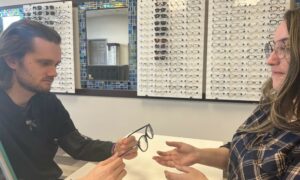 More than half of ECP offices have in-house finishing equipment, according to The Vision Council’s 2013 Eye Care Professional Report. Approximately 53.7 percent of all ECP locations responding to the report’s survey indicated that they currently possess in-house finishing equipment. This figure is slightly higher than previous estimates that gauged the prevalence of in-house edgers.
More than half of ECP offices have in-house finishing equipment, according to The Vision Council’s 2013 Eye Care Professional Report. Approximately 53.7 percent of all ECP locations responding to the report’s survey indicated that they currently possess in-house finishing equipment. This figure is slightly higher than previous estimates that gauged the prevalence of in-house edgers.
Some locations were more likely than others to only have in-house finishing capabilities. In particular, independent opticianry chains, large independent practices, practices with two to five locations, practices located in the Northeast and Southeast and practice locations dispensing six or more jobs per day were more likely than other organizations to possess just in-house finishing equipment.
There are two major reasons to have in-office edging or finishing equipment: reducing cost of goods and improving speed of delivery.
Reduce Costs
There is a reduction in cost of goods by having in-office edging or finishing equipment. From the MBA data, we know the median cost of goods expense percentage is 30 percent. This number can be reduced to 25 percent overnight with in-office edging or finishing equipment. Five percent is a large number. In a $1 million gross revenue practice, 5 percent equals $50,000. That money drops straight down to the practice net. That money could buy a new employee, a year of college for one of your children or simply go into your investments, and if done early enough in your career, let you retire a year earlier. Thinking long term, if you run the numbers out over 30 years, $50,000/year equals $1.5 million. That should be significant enough of a number to get your attention.
Improve Delivery Speed
The second reason for having in-office edging or finishing equipment is improving speed of delivery. We live in an instant on, microwave oven, cell telephone world. Patients do not want to wait two weeks for a new pair of glasses. In today’s world, patients want everything now. Looking at buying patterns, many patients are willing to pay more for convenience. Since convenience is such a powerful driver for patients, it is always important for us to consider ways to improve convenience.
With such powerful arguments for it, why doesn’t everyone have in-office edging or finishing equipment? The two most important arguments against it are: increased complexity of practice and premium lenses.
Some doctors don’t want any more practice management responsibility. To add more equipment and staff to run the equipment is just too much. Even though the newest equipment is very easy to run, it’s simply easier to send the spectacle lens jobs to a lab.
Premium lenses and specialty lenses are the future of our profession. Everything else will eventually be available over the internet. Now is the time to position the practice for the future. Damage to one premium lens during the in-office lab procedures wipes out the profit over the next several lenses. Additionally, to take advantage of the newest and most technologically advanced lenses requires the lens order to be sent out of the office. Deciding what lenses to prescribe in your practice is a strategic decision.
TASK: Review Lens Ordering
Your task for this week is to review your office spectacle lens ordering procedures.
- –Look at your Rx Analysis Report from your optical laboratories.
- –What lenses are you prescribing for your practice?
- –Strategically, are these the lenses that are best for your patients?
The bottom line question: Is there a place in your practice for in-office edging or finishing?

























